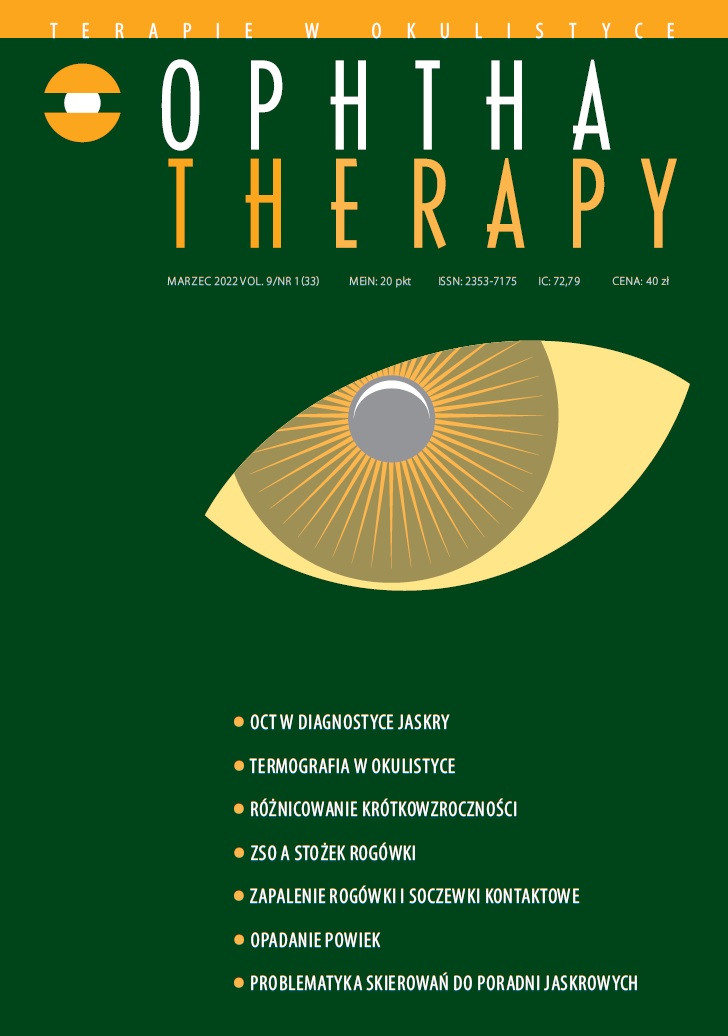Ptosis – diagnostics and treatment Review article
Main Article Content
Abstract
It is estimated that the low position of the upper eyelid affects over 1 million patients in Poland. Ptosis limits the visual field, causes compensatory head positions and the feeling of visual deterioration. The unaesthetic appearance of the eyes additionally contributes to low self-esteem. The aim of this article is to review modern diagnostic algorithms used in the case of a dropped eyelid. The paper also discusses the surgical techniques that are used in the case of ptosis and the guidelines for the correct qualification of the patient to a given surgical method.
Downloads
Article Details

This work is licensed under a Creative Commons Attribution-NonCommercial-NoDerivatives 4.0 International License.
Copyright: © Medical Education sp. z o.o. License allowing third parties to copy and redistribute the material in any medium or format and to remix, transform, and build upon the material, provided the original work is properly cited and states its license.
Address reprint requests to: Medical Education, Marcin Kuźma (marcin.kuzma@mededu.pl)
References
2. Forman WM, Leatherbarrow B, Sridharan GV et al. Acommunity survey of ptosis of the eyelid and pupil size of elderly people. Age Ageing. 1995; 24: 21-4.
3. Farber SE, Codner MA. Evaluation and management of acquired ptosis. Plast Aesthet Res. 2020; 7: 20.
4. Potemkin VV, Goltsman EV. Algorithm of objective examination of a patient with blepharoptosis. Ophthal J. 2019; 12(1): 45-51.
5. Grob SR, Cypen SG, Tao JP. Acquired Ptosis. Springer Nature Switzerland AG 2020.
6. Pauly M, Sruthi R. Ptosis: Evaluation and management. Kerala J Ophthalmol. 2019; 31: 11-6.
7. Nair AG, Patil-Chhablani P, Venkatramani D et al. Ocular myasthenia gravis: A review. Indian J Ophthalmol. 2014; 62(10): 985-91.
8. Monsul NT, Patwa HS, Knorr AM et al. The effects of prednisone on the progression from ocular to generalized myasthenia gravis. J Neurol Sci. 2004; 217: 131-3.
9. Jones LT, Quickert MH, Wobig JL. The cure of ptosis by aponeurotic repair. Arch Ophthalmol. 1975; 93: 629-34.
10. Anderson RL, Dixon RS. Aponeurotic ptosis surgery. Arch Ophthalmol. 1979; 97: 1123-8.
11. Laplant JF, Kang JY, Cockerham KP. Ptosis repair: external levator advancement vs. Muller’s muscle conjunctiva resection – techniques and modifications. Plast Aesthet Res. 2020; 7: 60.
12. Liao SL, Chuang AY. Various Modifications on Müller’s Muscle-Conjunctival Resection for Ptosis Repair. Arch Aesthetic Plast Surg. 2015; 21(2): 31-6.
13. Shubhra G, Cat Nguyen B. Expert Techniques in Ophthalmic Surgery; Chapter-61 Ptosis Repair: Müllerectomy 2019.
14. Fasanella RM, Servat J. Levator resection for minimal ptosis: another simplified operation. Arch Ophthalmol. 1961; 65: 493-6.
15. Beard C. The surgical treatment of blepharoptosis: a quantitative approach. Trans Am Ophthalmol Soc. 1966; 64: 401-5.
16. Putterman AM, Urist MJ. Müller’s muscle-conjunctival resection. Arch Ophthalmol. 1975; 93(8): 619-23.
17. Crawford JS. Repair of blepharoptosis with a modification of the Fasanella-Servat operation. Can J Ophthalmol. 1973; 8: 19-23.
18. Patel RM, Aakalu VK, Setabutr P et al. Efficacy of Muller’s Muscle and Conjunctiva Resection With or Without Tarsectomy for the Treatment of Severe Involutional Blepharoptosis. Ophthalmic Plast Reconstr Surg. 2017; 33(4): 273-8.

